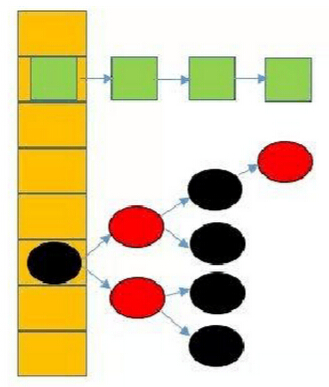JAVA JDK7和JDK8中HashMap的实现
来源:互联网 发布:护卫神linux 编辑:程序博客网 时间:2024/06/05 06:46
JDK7中的HashMap
HashMap底层维护着一个数组,数组中的每一项都是一个Entry
transient Entry<K,V>[] table;存入HashMap的键值对key-value以Entry对象的形式都存储在该table数组中
static class Entry<K,V> implements Map.Entry<K,V> { final K key; V value; Entry<K,V> next; int hash; }Entry放在数组的位置称为位桶或者Hash桶,原因是相同Hash码的对象会放在同一位置,使用链表相连,该hashcode是通过key来计算的
final int hash(Object k) { int h = 0; h ^= k.hashCode(); h ^= (h >>> 20) ^ (h >>> 12); return h ^ (h >>> 7) ^ (h >>> 4);}通过hash计算出来的值会使用indexFor方法找到对应的table下标
[通过计算hashcode和数组下标最大值的与运算 – 相当于用hashcode对table.length取模]
static int indexFor(int h, int length) { return h & (length-1);}当两个key的hashCode相同时,就产生了哈希冲突,HashMap解决哈希冲突使用链表法。
当产生哈希冲突时,把存放在数组中的Entry的值设置为新值的next.
所以当哈希冲突很多时,HashMap退化成链表
总结插入元素的过程:
当向HashMap中put一对key-value时,会先根据key的hashCode计算出在table数组中存放的位置,如果该位置没有对象存在,就直接把该对象放进数组中;如果已经有对象存在,先顺着该对象的链开始查找[因为不允许存在相同的key],如果存在相同的key,就更新value值;否则将新对象插入到链表尾部。
ps:注意,key为null时,都放到table[0]中(HashMap的key,value都可以为null)
private V putForNullKey(V value) { for (Entry<K,V> e = table[0]; e != null; e = e.next) { if (e.key == null) { V oldValue = e.value; e.value = value; e.recordAccess(this); return oldValue; } } modCount++; addEntry(0, null, value, 0); return null;}当size大于threshold时会产生扩容,threshold = capacity * loadfactor = 0.75*16
void addEntry(int hash, K key, V value, int bucketIndex) { if ((size >= threshold) && (null != table[bucketIndex])) { resize(2 * table.length); hash = (null != key) ? hash(key) : 0; bucketIndex = indexFor(hash, table.length); } createEntry(hash, key, value, bucketIndex);}JDK7中扩容,只有当size>=threshold且要插入table的位置中已经存在对象才会发生扩容。且每次扩大到(当前长度+1)*2,即扩大当前容量的一倍
JDK8中的HashMap
一直到JDK7,HashMap的结构都是基于一个数组和多个链表来实现的,哈希冲突的时候就以链表的形式存储。
这样可能存在的问题是如果有很多节点发生碰撞的话,存储在一个链表中,如果要查找其中一个节点,就不可避免的花费O(N)的查找事件。这是很大的性能损失。
因此在JDK8中采用的是位桶+链表/红黑树的方式,也是非线程安全的。当某个位桶的链表长度达到某个阈值的时候,就会转换成红黑树

JDK8中当同一个哈希值的节点数大于等于8时,就会被调整成一颗红黑树。
Entry的名字编程了Node
transient Node<K,V>[] table;阈值是8
static final int TREEIFY_THRESHOLD = 8;插入的方法也有很大的变化
public V put(K key, V value) { return putVal(hash(key), key, value, false, true); }final V putVal(int hash, K key, V value, boolean onlyIfAbsent, boolean evict) { Node<K,V>[] tab; Node<K,V> p; int n, i; //如果当前map中无数据,执行resize方法。并且返回n if ((tab = table) == null || (n = tab.length) == 0) n = (tab = resize()).length; //如果要插入的键值对要存放的这个位置刚好没有元素,那么把他封装成Node对象,放在这个位置上就完事了 if ((p = tab[i = (n - 1) & hash]) == null) tab[i] = newNode(hash, key, value, null); //否则的话,说明这上面有元素 else { Node<K,V> e; K k; //如果这个元素的key与要插入的一样,那么就替换一下,也完事。 if (p.hash == hash && ((k = p.key) == key || (key != null && key.equals(k)))) e = p; //1.如果当前节点是TreeNode类型的数据,执行putTreeVal方法 else if (p instanceof TreeNode) e = ((TreeNode<K,V>)p).putTreeVal(this, tab, hash, key, value); else { //还是遍历这条链子上的数据,跟jdk7没什么区别 for (int binCount = 0; ; ++binCount) { if ((e = p.next) == null) { p.next = newNode(hash, key, value, null); //2.完成了操作后多做了一件事情,判断,并且可能执行treeifyBin方法 if (binCount >= TREEIFY_THRESHOLD - 1) // -1 for 1st treeifyBin(tab, hash); break; } if (e.hash == hash && ((k = e.key) == key || (key != null && key.equals(k)))) break; p = e; } } if (e != null) { // existing mapping for key V oldValue = e.value; if (!onlyIfAbsent || oldValue == null) //true || -- e.value = value; //3. afterNodeAccess(e); return oldValue; } } ++modCount; //判断阈值,决定是否扩容 if (++size > threshold) resize(); //4. afterNodeInsertion(evict); return null; }indexFor方法也被删除,直接使用(tab.length-1)&hash
static final int hash(Object key) { int h; return (key == null) ? 0 : (h = key.hashCode()) ^ (h >>> 16);}- JAVA JDK7和JDK8中HashMap的实现
- JDK7与JDK8中HashMap的实现
- JDK7与JDK8中HashMap的实现
- JDK7与JDK8中HashMap的实现
- JDK7与JDK8中HashMap的实现
- JDK7与JDK8中HashMap的实现
- JDK7 与 JDK8 中 HashMap 的实现
- JDK7 与 JDK8 中 HashMap 的实现
- JDK7与JDK8中HashMap的实现
- JDK7与JDK8中HashMap的实现
- JDK7与JDK8中HashMap的实现
- jdk7中hashmap实现原理和jdk8中hashmap的改进方法总结
- JDK7与JDK8中HashMap的实现的区别
- JDK7和JDK8中HashMap的结构优化
- JDK7与JDK8中HashMap的比较
- JDK7与JDK8中HashMap的区别
- eclipse中,jdk7和jdk8并存开发的实现方式
- 实现jdk7和jdk8的自由切换
- Caffe中实现多标签数据准备及训练
- 更改CentOS默认yum镜像源为国内的yum镜像源
- 520. Detect Capital
- js-验证码插件gVerify.js
- git仓库管理
- JAVA JDK7和JDK8中HashMap的实现
- windows本地代码同步到Linux开发服务器的方法
- 通过例子学设计模式之--组合模式以及使用场景说明(C++实现)
- 算法课W1·leetcode 654. Maximum Binary Tree
- 线程
- 微信授权
- 消息中间件和JMS
- Oracle处理小数点后位数、格式化数字、查找指定字符所在位置的几个函数
- 题目97-兄弟郊游问题


